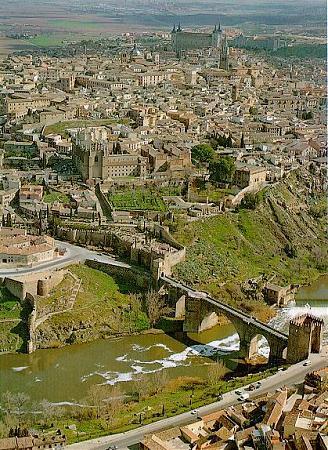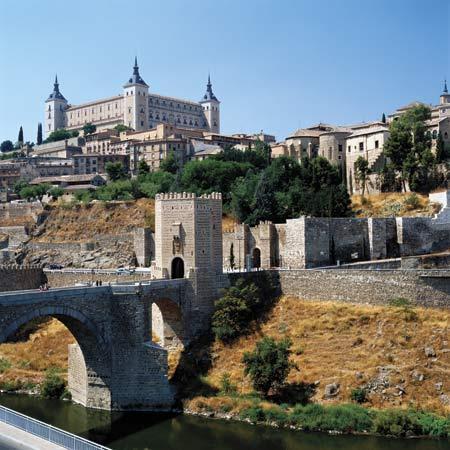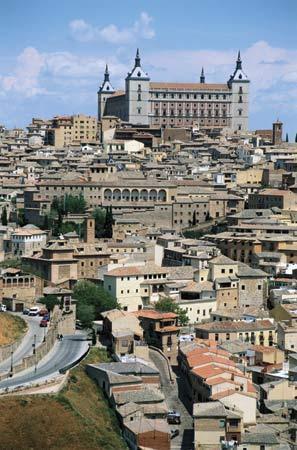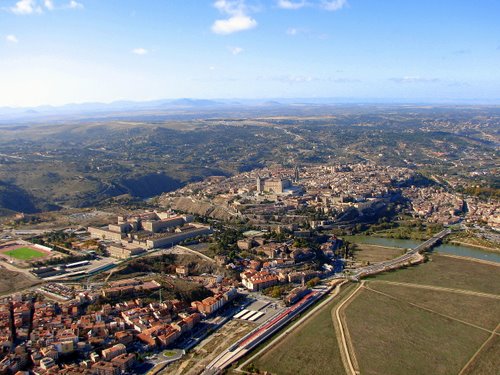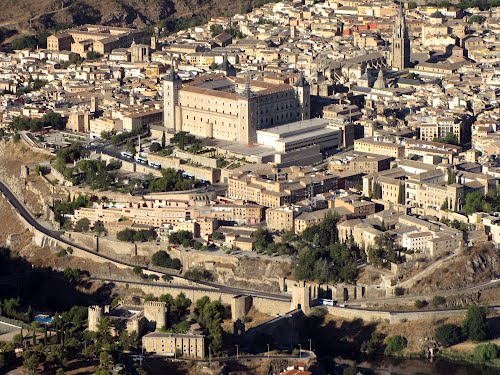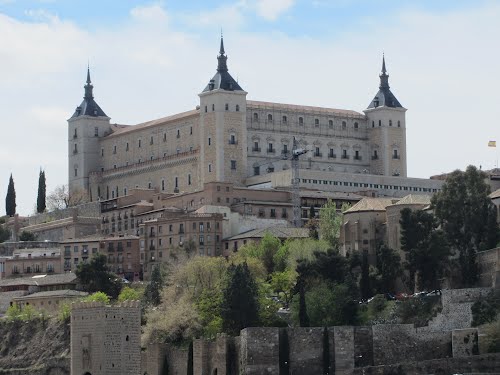Toledo is a municipality located in central Spain, 70 km south of Madrid. It is the capital of the province of Toledo and the autonomous community of Castile-La Mancha. It was declared a World Heritage Site by UNESCO in 1986 for its extensive cultural and monumental heritage and historical co-existence of Christian, Muslim and Jewish cultures.
Toledo is known as the "Imperial City" for having been the main venue of the court of Charles I, and as the "City of the Three Cultures", having been influenced by a historical co-existence of Christians, Muslims and Jews. In 1085, the city fell to Alfonso VI of Castile as the first major city in the Christian Reconquista. Toledo has a history in the production of bladed weapons, which are now popular souvenirs of the city.
People who were born or have lived in Toledo include Brunhilda of Austrasia, Al-Zarqali, Garcilaso de la Vega, Eleanor of Toledo, Alfonso X and El Greco. It was also the place of important historic events such as the Visigothic Councils of Toledo.
Main sights
The city of Toledo was declared a Historic-Artistic Site in 1940, UNESCO later given the title of World Heritage in 1987. Sights include:
- ● Tomb of Saint Beatrice of Silva, founder of the Order of the Immaculate Conception, at the Conceptionist Monastery of Toledo.
- ● Castillo de San Servando, medieval castle near the banks of the Tagus river and the Infantry Academy.
- ● The Gothic Cathedral, dating from the thirteenth century. Inside there is the Clear from Narciso Tome, in Baroque.
- ● Monasterio de San Juan de los Reyes, in Elizabethan Gothic style (15th century).
- ● The Renaissance Museo-Hospital de Santa Cruz (16th century).
- ● El Greco Museum, a house-museum designed as a recreation of the artist's home, which was lost centuries ago. It houses several important paintings.
- ● Santa Maria la Blanca, the oldest synagogue building in Europe still standing, now owned by the Catholic Church.
- ● Synagogue of El Transito, in the Jewish Quarter. It is home to the Sephardic Museum.
- ● Hospital de Tavera Museum Duque de Lerma. Renaissance style, dates from the sixteenth century. Influenced the layout of El Escorial.
- ● Church of Santiago del Arrabal, in Mudejar style.
- ● Iglesia de Santo Tome. Mudejar style, the fourteenth century, houses the famous Burial of Count Orgaz, by El Greco.
- ● El Cristo de la Luz, a small mosque-oratory built in 999, later extended with Mudejar apse for conversion into a church.
- ● Galiana Palace (13th century), in Mudejar style.
- ● Tornerias Mosque (11th century).
- ● Alcazar fortress (16th century), located in the highest part of town, overlooking the city. From 2009 it houses the collection of the Army Museum.
- ● Puerta de Bisagra Nueva, the main entrance and face of Toledo.
- ● Puerta de Bisagra, the main entrance to the city in Andalusian times.
- ● Puerta del Sol. Mudejar style and built by the Knights Hospitallers in the fourteenth century.
- ● Puerta Bab al-Mardum, the oldest city gate of Toledo.
- ● New Gate of Hinge, by Alonso de Covarrubias (16th century, based on Arabic structures).
- ● Old door hinge or Puerta de Alfonso VI.
- ● Cambron gate, of Muslim-16th century origin.
- ● San Roman (Museum of the Councils and Visigoth culture).
- ● Ermita del Cristo de la Vega, in Mudejar style (11th century).
- ● Alcantara bridge, Roman bridge across the Tagus.
- ● Puente de San Martin, medieval bridge across the Tagus.
To mark the fourth centenary of the publication of the first part of Don Quixote, the Council of Communities of Castile - La Mancha designed a series of routes through the region crossing the various points cited in the novel. Known as the Route of Don Quixote, two of the pathways designated, sections 1 and 8, are based in Toledo, those linking the city with La Mancha Castile and Montes de Toledo exploit the natural route which passes through the Cigarrales and heads to Cobisa, Nambroca Burguillos of Toledo, where it takes the Camino Real from Sevilla to suddenly turn towards Mascaraque Almonacid de Toledo, deep into their surroundings, near Mora, in La Mancha.
This stretch, Mascaraque-Toledo, of the Route of Don Quixote has recently been included in an official way on the Camino de Santiago in Levantine branch with origins in Cartagena, Alicante and Valencia, as both routes are declared a European Cultural Route on this stretch.
History
Toledo is mentioned by the Roman historian Livy (ca. 59 BCE – 17 CE) as “a small city, but fortified by location”. Roman general Marcus Fulvius Nobilior fought a battle near the city in 193 BCE against a confederation of Celtic tribes including the Vaccaei, Vettones, and Celtiberi, defeating them and capturing a king called Hilermus. At that time, Toletum was a city of the Carpetani tribe, and part of the region of Carpetania. It was incorporated into the Roman Empire as a civitas stipendiaria, that is, a tributary city of non-citizens. It later achieved the status of municipium by Flavian times. With this status, city officials, even of Carpetani origin, obtained Roman citizenship for public service, and the forms of Roman law and politics were increasingly adopted. At approximately this time were constructed in Toletum a Roman circus, city walls, public baths, and a municipal water supply and storage system.
The Roman circus in Toledo was one of the largest in Hispania. Chariot races were held on special holidays and were also commissioned by private citizens to celebrate career achievements. A fragmentary stone inscription records circus games paid for by a citizen of unknown name to celebrate his achieving the sevirate, a kind of priesthood conferring high status. Archaeologists have also identified portions of a special seat of the sort used by the city elites to attend circus games, called a sella curulis. The circus could hold up to 15000 spectators.
During Roman times, Toledo was never a provincial capital nor a conventus iuridicus. It started to gain importance in late antiquity. There are indications that large private houses within the city walls were enlarged, while several large villas were built north of the city through the third and fourth centuries. Games were held in the circus into the late fourth and early fifth centuries C.E., also an indication of active city life and ongoing patronage by wealthy elites. A church council was held in Toledo in the year 400 to discuss the conflict with Priscillianism. A second council of Toledo was held in 527. The Visigothic king Theudis was in Toledo in 546, where he promulgated a law. This is strong though not certain evidence that Toledo was the chief residence for Theudis. King Athanagild died in Toledo, probably in 568. Although Theudis and Athangild based themselves in Toledo, Toledo was not yet the capital city of the Iberian peninsula, as Theudis and Athangild's power was limited in extent, the Suevi ruling Galicia and local elites dominating Lusitania, Betica, and Cantabria. This changed with Liuvigild, who brought the peninsula under his control. The Visigoths ruled from Toledo until the Moors conquered the Iberian peninsula in the early years of 8th century (711–719).
Visigothic Toledo
A series of church councils was held in Toledo under the Visigoths. A synod of Arian bishops was held in 580 to discuss theological reconciliation with Nicene Christianity. Liuvigild's successor, Reccared, hosted the third council of Toledo, at which the Visigothic kings abandoned Arianism and reconciled with the existing Hispano-Roman episcopate. A synod held in 610 transferred the metropolitanate of the old province of Carthaginensis from Cartagena to Toledo. At that time, Cartagena was ruled by the Byzantines, and this move ensured a closer relation between the bishops of Spain and the Visigothic kings. King Sisebut forced Jews in the Visigothic kingdom to convert to Christianity, this act was criticized and efforts were made to reverse it at the Fourth Council of Toledo in 633. The Fifth and Sixth Councils of Toledo placed church sanctions on anyone who would challenge the Visigothic kings. The Seventh Council of Toledo instituted a requirement that all bishops in the area of a royal city, that is, of Toledo, must reside for one month per year in Toledo. This was a stage in "the elevation of Toledo as the primatial see of the whole church of the Visgothic kingdom". In addition, the seventh council declared that any clergy fleeing the kingdom, assisting conspirators against the king, or aiding conspirators, would be excommunicated and no one should remove this sentence. The ban on lifing these sentences of excommunication was lifted at the Eighth Council of Toledo in 653, at which, for the first time, decisions were signed by palace officials as well as bishops.
The eighth council of Toledo took measures that enhanced Toledo's significance as the center of royal power in the Iberian peninsula. The council declared that the election of a new king following the death of the old one should only take place in the royal city, or wherever the old king died. In practice this handed the power to choose kings to only such palace officials and military commanders who were in regular attendance on the king. The decision also took king-making power away from the bishops, who would be in their own sees and would not have time to come together to attend the royal election. The decision did allow the bishop of Toledo, alone among bishops, to be involved in decisions concerning the royal Visigothic succession. The ninth and tenth councils were held in rapid succession in 655 and 656.
When Reccesuinth died in 672 at his villa in Gerticos, his successor Wamba was elected on the spot, then went to Toledo to be anointed king by the bishop of Toledo, according to the procedures laid out in prior church councils. In 673, Wamba defeated a rebel duke named Paul, and held his victory parade in Toledo. The parade included ritual humiliation and scalping of the defeated Paul. Wamba carried out renovation works in Toledo in 674-675, marking these with inscriptions above the city gates that are no longer extant but were recorded in the eighth century. The Eleventh Council of Toledo was held in 675 under king Wamba. Wamba weakened the power of the bishop of Toledo by creating a new bishopric outside Toledo at the church of Saints Peter and Paul. This was one of the main churches of Toledo and was the church where Wamba was anointed king, and the church from which Visigothic kings departed for war after special ceremonies in which they were presented with a relic of the True Cross. By creating a new bishopric there, Wamba removed power over royal succession from the bishop of Toledo and granted it to the new bishop. The Twelfth Council of Toledo was held in 681 after Wamba's removal from office. Convinced that he was dying, Wamba had accepted a state of penitence that according to the decision of a previous church council, made him inelegible to remain king. The Twelfth Council, led by newly installed bishop Julian confirmed the validity of Wamba's removal from office and his succession by Ervig. The Twelfth Council eliminated the new bishopric that Wamba had created and returned the powers over succession to the bishop of Toledo.
The Twelfth Council of Toledo approved 28 laws against the Jews. Julian of Toledo, despite a Jewish origin, was strongly anti-Semitic as reflected in his writings and activities. The leading Jews of Toledo were assembled in the church of Saint Mary on January 27, 681, where the new laws were read out to them.
The Thirteenth, Fourteenth, and Fifteenth Councils of Toledo were held in 683, 684, and 688. The Thirteenth Council restored property and legal rights to those who had rebelled against King Wamba in 673. The Thirteenth Council also approved laws protecting the king's family after the king's death. In 687, Ervig took the penitent state before dying, and the kingship passed to Egica, who was anointed king in Toledo on November 24. In 688, the Fifteenth Council lifted the ban on taking property from the families of former kings, whereupon Egica was able to plunder Ervig's family properties.
In the late seventh century, Toledo became a main center of literacy and writing in the Iberian peninsula. Toledo's development as a center of learning was influenced by Isidore of Seville, an author and advocate of literacy who attended several church councils in Toledo. King Chindasuinth had a royal library in Toledo, and at least one count called Laurentius had a private library. Sometime before 651, Chindasuinth sent the bishop of Zaragoza, Taio, to Rome to obtain books that were not available in Toledo. Taio obtained, at least, parts of pope Gregory's Moralia. The library also contained a copy of a Hexameron by Dracontius, which Chindasuinth liked so much that he commissioned Eugenius II to revise it by adding a new part dealing with the seventh day of creation. Chindasuinth issued laws that were gathered together in a book called Liber Iudiciorum by his successor Reccesuinth in 654, this book was revised twice, widely copied, and was an important influence on medieval Spanish law. Three bishops of Toledo wrote works that were widely copied and disseminated in western Europe and parts of which survive to this day: Eugenius II, Ildefonsus, and Julian.
In 693, the Sixteenth Council of Toledo condemned Sisebert, Julian's successor as bishop of Toledo, for having rebelled against King Egica in alliance with Liuvigoto, the widow of king Ervig. A rebel king called Suniefred seized power in Toledo briefly at about this time. Whether or not Sisebert's and Suniefred's rebellions were the same or separate is unknown. Suniefred is known only from having minted coins in Toledo during what should have been Egica's reign. The Seventeenth Council of Toledo was held in 694. The Eighteenth Council of Toledo, the last one, took place shortly after Egica's death around 702 or 703.
By the end of the seventh century the bishop of Toledo was the leader of the Spanish bishops, a situation unusual in Europe: "The metropolitan bishops of Toledo had achieved by the last quarter of the seventh century an authority and a primacy that was unique in Western Europe. Not even the pope could count on such support from neighbouring metropolitans." Toledo had been matched by no other city in western Europe outside Italy as the governmental and symbolic center of a powerful monarchy." Toledo had "emerged from relative obscurity to become the permanent governmental centre of the Visigothic monarchy; a true capital, whose only equivalent in western Europe was to be Lombard Pavia."
When Wittiza died around 710, Ruderic became Visigothic king in Toledo, but the kingdom was split, as a rival king Achila ruled Tarraconensis and Narbonensis. Meanwhile, Arabic and Berber troops under Musa ibn Nusayr had conquered Tangiers and Ceuta between 705 and 710, and commenced raids into the Visigothic kingdom in 711. Ruderic led an army to confront the raiders. He was defeated and killed in battle, apparently after being betrayed by Visigothic nobles who wished to replace him as king and did not consider the Arabs and Berbers a serious threat. The commander of the invading forces was Tariq bin Ziyad, a Luwata Berber freedman in the service of governor Musa. It is possible that a king called Oppa ruled in Toledo between Ruderic's death and the fall of Toledo. Tariq, seizing the opportunity presented by the death of Ruderic and the internal divisions of the Visigothic nobles, captured Toledo, in 711 or 712. Governor Musa disembarked in Cádiz and proceeded to Toledo, where he executed numerous Visigothic nobles, thus destroying much of the Visigothic power structure. Collins suggests that the Visigothic emphasis on Toledo as the center of royal ceremony became a weakness. Since the king was chosen in or around Toledo, by nobles based in Toledo, and had to be anointed king by the bishop of Toledo in a church in Toledo, when Tariq captured Toledo and executed the Visigothic nobles, having already killed the king, there was no way for the Visigoths to select a legitimate king.
Toledo under Arab rule
Soon after the conquest, Musa and Tariq returned to Damascus. The Arab center of administration was placed first in Seville, then moved to Cordoba. With most of the rest of the Iberian peninsula, Toledo was ruled from Cordoba by the governor of Al-Andalus, under the ultimate notional command of the Umayyad Caliph in Damascus. Arab conquerors had often replaced former capital cities with new ones to mark the change in political power. The invaders were ethnically diverse, and available evidence suggests that in the area of Toledo, Berber settlement predominated over Arab.
In 742 the Berbers in Al-Andalus rebelled against the Arab Omeyyad governors. They took control of the north and marched south, laying siege to Toledo. After a siege of one month the Berber troops were defeated outside Toledo by troops sent from Cordoba by the governor Abd al-Malik ibn Katan and commanded by the governor's son. However, while Ibn Katan's troops were engaged with the Berbers, his Arab allies betrayed and killed him and took over Cordoba. After the Arabs' first leader, Talama ibn Salama, died, Yusuf al-Fihri became ruler of Al-Andalus. The Omeyyad dynasty in Damascus collapsed and Yusuf ruled independently with the support of his Syrian Arab forces. The Qays Arab commander As-Sumayl was made governor of Toledo under Yusuf around 753.
In 756 Abd ar-Rahman, a descendant of the fallen Omeyyad caliphs, came to Al-Andalus and initiated a revolt against Yusuf. He defeated Yusuf and forced him to reside in Cordoba, but Yusuf broke the agreement and raised a Berber army to fight Abd ar-Rahman. In this conflict, Toledo was held against Abd ar-Rahman by Yusuf's cousin Hisham ibn Urwa. Yusuf attempted to march on Seville, but was defeated and instead attempted to reach his cousin in Toledo. He was either killed on his way to Toledo, or he reached Toledo and held out there for as many as two or three years before being betrayed and killed by his own people. Whether or not Yusuf himself held out in Toledo, Hisham ibn Urwa did hold power in Toledo for several years, resisting the authority of Abd ar-Rahman. In 761 Hisham is reported as again being in rebellion in Toledo against Abd ar-Rahman. Abd ar-Rahman failed to take Toledo by force and instead signed a treaty allowing Hisham to remain in control of Toledo, but giving one of his sons as hostage to Abd ar-Rahman. Hisham continued to defy Abd ar-Rahman, who had Hisham's son executed and the head catapulted over the city walls into Toledo. Abd ar-Rahman attacked Toledo in 764, winning only when some of Hisham's own people betrayed him and turned him over to Abd ar-Rahman and his freedman Badr. Ibn al-Athir states that towards the end of Abd ar-Rahman's reign, a governor of Toledo raided in force into the Kingdom of Asturias during the reign of Mauregatus, though the Asturian chronicles do not record the event.
Under the Umayyad Emirate of Cordoba, Toledo was the centre of numerous insurrections dating from 761 to 857. Twenty years after the rebellion of Hisham ibn Urwa, the last of Yusuf's sons, Abu al-Aswad ibn Yusuf, rebelled in Toledo in 785. After the suppression of ibn Yusuf's revolt, Abd ar-Rahman's oldest son Sulayman was made governor of Toledo. However, Abd ar-Rahman designated as his successor a younger son, Hisham. On Hisham's accession to the Emirate in 788, Sulayman refused to make the oath of allegiance at the mosque, as succession custom would have dictated, and thus declared himself in rebellion. He was joined in Toledo by his brother Abdallah. Hisham laid siege to Toledo. While Abdallah held Toledo against Hisham, Sulayman escaped and attempted to find support elsewhere, but was unsuccessful. In 789, Abdallah submitted and Hisham took control of Toledo. The following year, Sulayman gave up the fight and went into exile. Hisham's son Al-Hakam was governor of Toledo from 792 to 796 when he succeeded his father as emir in Cordoba. After Al-Hakam's accession and departure, a poet resident in Toledo named Girbib ibn-Abdallah wrote verses against the Omeyyads, helping to inspire a revolt in Toledo against the new emir in 797. Chroniclers disagree as to the leader of this revolt. Al-Hakam sent Amrus ibn Yusuf to fight the rebellion. Amrus took control of the Berber troops in Talavera, from where he was able to convince some rebels to turn on their leader, and thus take control of Toledo. Amrus was governor of Toledo until 802.
The Banu Qasi gained nominal control of the city until 920 and in 932 Abd-ar-Rahman III captured the city following an extensive siege. Toledo experienced a period known as La Convivencia, i.e. the co-existence of Jews, Christians, and Muslims. Under Islamic Arab rule, Toledo was called Ṭulayṭulah. After the fall of the caliphate, Toledo was the capital city of one of the richest Taifas of Al-Andalus. Its population was overwhelmingly Muladi, and, because of its central location in the Iberian Peninsula, Toledo took a central position in the struggles between the Muslim and Christian rulers of northern Spain. The conquest of Toledo by Alfonso VI of Castile in 1085 marked the first time a major city in Al-Andalus was captured by Christian forces; it served to sharpen the religious aspect of the Christian reconquest.
Medieval Toledo after the Reconquest
On May 25, 1085, Alfonso VI of Castile took Toledo and established direct personal control over the Moorish city from which he had been exacting tribute, ending the medieval Taifa's Kingdom of Toledo. This was the first concrete step taken by the combined kingdom of Leon-Castile in the Reconquista by Christian forces. After Castilian conquest, Toledo continued to be a major cultural centre; its Arab libraries were not pillaged, and a tag-team translation centre was established in which books in Arabic or Hebrew would be translated into Castilian by Muslim and Jewish scholars, and from Castilian into Latin by Castilian scholars, thus letting long-lost knowledge spread through Christian Europe again. For some time during the 16th century, Toledo served as the capital city of Castile, and the city flourished. However, soon enough the Spanish court was moved, first to Valladolid and then to Madrid, thus letting the city's importance dwindle until the late 20th century, when it became the capital of the autonomous community of Castile-La Mancha. Nevertheless, the economic decline of the city helped to preserve its cultural and architectural heritage. Today, because of this rich heritage, Toledo is one of Spain's foremost cities, receiving thousands of visitors yearly. Under the Roman Catholic Archdiocese of Toledo multiple persecutions and stake burnings of Jews occurred; the Kingdom of Toledo followed up on this tradition including forced conversions and mass murder and the rioting and blood bath against the Jews of Toledo.

